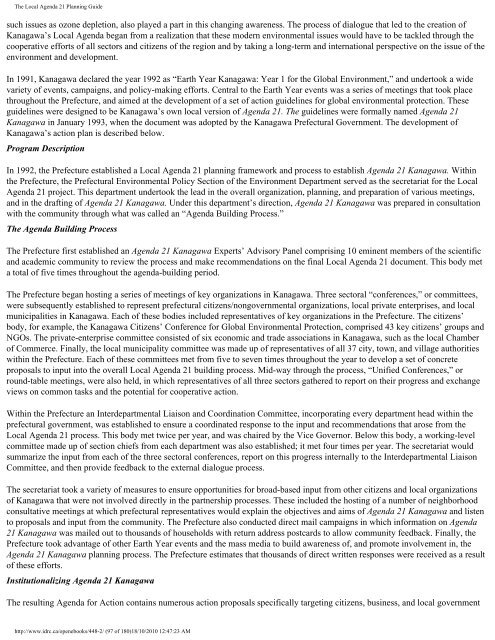The Local Agenda 21 Planning Guide - Democrats Against UN ...
The Local Agenda 21 Planning Guide - Democrats Against UN ...
The Local Agenda 21 Planning Guide - Democrats Against UN ...
Create successful ePaper yourself
Turn your PDF publications into a flip-book with our unique Google optimized e-Paper software.
<strong>The</strong> <strong>Local</strong> <strong>Agenda</strong> <strong>21</strong> <strong>Planning</strong> <strong>Guide</strong><br />
such issues as ozone depletion, also played a part in this changing awareness. <strong>The</strong> process of dialogue that led to the creation of<br />
Kanagawa’s <strong>Local</strong> <strong>Agenda</strong> began from a realization that these modern environmental issues would have to be tackled through the<br />
cooperative efforts of all sectors and citizens of the region and by taking a long-term and international perspective on the issue of the<br />
environment and development.<br />
In 1991, Kanagawa declared the year 1992 as “Earth Year Kanagawa: Year 1 for the Global Environment,” and undertook a wide<br />
variety of events, campaigns, and policy-making efforts. Central to the Earth Year events was a series of meetings that took place<br />
throughout the Prefecture, and aimed at the development of a set of action guidelines for global environmental protection. <strong>The</strong>se<br />
guidelines were designed to be Kanagawa’s own local version of <strong>Agenda</strong> <strong>21</strong>. <strong>The</strong> guidelines were formally named <strong>Agenda</strong> <strong>21</strong><br />
Kanagawa in January 1993, when the document was adopted by the Kanagawa Prefectural Government. <strong>The</strong> development of<br />
Kanagawa’s action plan is described below.<br />
Program Description<br />
In 1992, the Prefecture established a <strong>Local</strong> <strong>Agenda</strong> <strong>21</strong> planning framework and process to establish <strong>Agenda</strong> <strong>21</strong> Kanagawa. Within<br />
the Prefecture, the Prefectural Environmental Policy Section of the Environment Department served as the secretariat for the <strong>Local</strong><br />
<strong>Agenda</strong> <strong>21</strong> project. This department undertook the lead in the overall organization, planning, and preparation of various meetings,<br />
and in the drafting of <strong>Agenda</strong> <strong>21</strong> Kanagawa. Under this department’s direction, <strong>Agenda</strong> <strong>21</strong> Kanagawa was prepared in consultation<br />
with the community through what was called an “<strong>Agenda</strong> Building Process.”<br />
<strong>The</strong> <strong>Agenda</strong> Building Process<br />
<strong>The</strong> Prefecture first established an <strong>Agenda</strong> <strong>21</strong> Kanagawa Experts’ Advisory Panel comprising 10 eminent members of the scientific<br />
and academic community to review the process and make recommendations on the final <strong>Local</strong> <strong>Agenda</strong> <strong>21</strong> document. This body met<br />
a total of five times throughout the agenda-building period.<br />
<strong>The</strong> Prefecture began hosting a series of meetings of key organizations in Kanagawa. Three sectoral “conferences,” or committees,<br />
were subsequently established to represent prefectural citizens/nongovernmental organizations, local private enterprises, and local<br />
municipalities in Kanagawa. Each of these bodies included representatives of key organizations in the Prefecture. <strong>The</strong> citizens’<br />
body, for example, the Kanagawa Citizens’ Conference for Global Environmental Protection, comprised 43 key citizens’ groups and<br />
NGOs. <strong>The</strong> private-enterprise committee consisted of six economic and trade associations in Kanagawa, such as the local Chamber<br />
of Commerce. Finally, the local municipality committee was made up of representatives of all 37 city, town, and village authorities<br />
within the Prefecture. Each of these committees met from five to seven times throughout the year to develop a set of concrete<br />
proposals to input into the overall <strong>Local</strong> <strong>Agenda</strong> <strong>21</strong> building process. Mid-way through the process, “Unified Conferences,” or<br />
round-table meetings, were also held, in which representatives of all three sectors gathered to report on their progress and exchange<br />
views on common tasks and the potential for cooperative action.<br />
Within the Prefecture an Interdepartmental Liaison and Coordination Committee, incorporating every department head within the<br />
prefectural government, was established to ensure a coordinated response to the input and recommendations that arose from the<br />
<strong>Local</strong> <strong>Agenda</strong> <strong>21</strong> process. This body met twice per year, and was chaired by the Vice Governor. Below this body, a working-level<br />
committee made up of section chiefs from each department was also established; it met four times per year. <strong>The</strong> secretariat would<br />
summarize the input from each of the three sectoral conferences, report on this progress internally to the Interdepartmental Liaison<br />
Committee, and then provide feedback to the external dialogue process.<br />
<strong>The</strong> secretariat took a variety of measures to ensure opportunities for broad-based input from other citizens and local organizations<br />
of Kanagawa that were not involved directly in the partnership processes. <strong>The</strong>se included the hosting of a number of neighborhood<br />
consultative meetings at which prefectural representatives would explain the objectives and aims of <strong>Agenda</strong> <strong>21</strong> Kanagawa and listen<br />
to proposals and input from the community. <strong>The</strong> Prefecture also conducted direct mail campaigns in which information on <strong>Agenda</strong><br />
<strong>21</strong> Kanagawa was mailed out to thousands of households with return address postcards to allow community feedback. Finally, the<br />
Prefecture took advantage of other Earth Year events and the mass media to build awareness of, and promote involvement in, the<br />
<strong>Agenda</strong> <strong>21</strong> Kanagawa planning process. <strong>The</strong> Prefecture estimates that thousands of direct written responses were received as a result<br />
of these efforts.<br />
Institutionalizing <strong>Agenda</strong> <strong>21</strong> Kanagawa<br />
<strong>The</strong> resulting <strong>Agenda</strong> for Action contains numerous action proposals specifically targeting citizens, business, and local government<br />
http://www.idrc.ca/openebooks/448-2/ (97 of 180)18/10/2010 12:47:23 AM










